Interview with Architect Peter Eisenman

Architect Peter Eisenman is famed for, among other buildings, the Wexner Center for the Arts, the Aronoff Center for Design and Art, and the City of Culture in Galicia, Spain.
Eisenman also designed the Memorial to the Murdered Jews of Europe, located just one block south of the Brandenburg Gate in Berlin.
Recently, I spoke with Eisenman on the phone about the Memorial.
Do you remember when you first heard about the Holocaust?
My family came to the United States from Alsace-Lorraine in 1848, and I was born in Newark, New Jersey in 1932. Nobody we knew was in the Holocaust. My grandmother, actually, was an anti-Semite, and used to boast that her grandfather was buried in a gentile cemetery. I did not have a religious upbringing, and in fact, I didn’t know I was Jewish until I was 10 years old.
There was a design competition for the Holocaust memorial in Berlin which I almost didn’t enter because at the time, I didn’t have any feeling for it, or any sense that I should do it. I’ll mention that I was in psychoanalysis for twenty years, which brought me face to face with my own ambivalence about being Jewish. I identify with Jewishness culturally, but I am not religious.
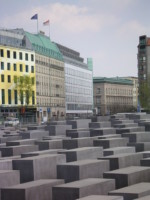
(Photo by Stefan Wagner)
What do you think of Germany today?
It happens always that I leave the U.S. as an American architect and return from Germany as a Jew. This philo-Semitism that exists in Germany is a very strange thing. You say “Hello” to somebody, and immediately they say “Oh my grandfather wasn’t involved.” I think to myself: “I didn’t ask you that; I just said hello.” On the part of many Germans, there’s this overweening sense of guilt, and of trying to compensate, that makes one feel more Jewish than does anything else.
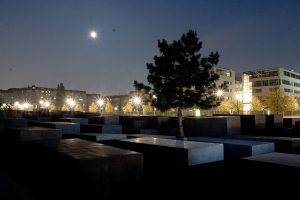
(Photo by Matthias E. Johansson)
Which books might you recommend to give people insight into the Memorial to the Murdered Jews of Europe?
There is a good book simply titled Holocaust Memorial Berlin. And I especially like the writings of the Italian philosopher Giorgio Agamben on the Memorial.
(Ed. — Giorgio Agamben published an essay about the memorial translated into German for Die Zeit. To read Johan Åhr’s English-language essay about the Memorial, complete with a bibliography at its end, go here.)
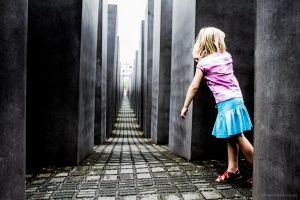
(Photo by Chocolate Media)
Please tell me something about the genesis of the Memorial to the Murdered Jews of Europe.
The Memorial project was going to be defeated as an idea when Helmut Kohl lost the election and Gerhard Schröder came in on a platform to deny building it.
The project had been controversial for the Jewish community in Berlin, as well as for Israelis, largely because it contains no Jewish imagery. What caused a sea change in their attitude, though, was an anti-Semitic speech given by the German writer Martin Walser. Walser’s speech suddenly animated the Jewish community of Berlin to want the memorial built. The move to get the memorial built was than negotiated brilliantly by Michael Naumann, a former German Secretary of Culture who at the time was editor of the German newspaper Die Zeit. Michael made it mandatory for the decision about the memorial to be made by the German Bundestag. Thereafter, by law, a memorial would have to be built. I actually submitted three different designs for a Holocaust memorial; the one in place today is the one they chose. I remember the June day that they announced the Bundestag would do this — it was very exciting.
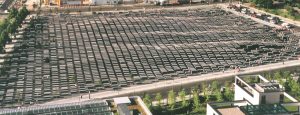
(The Memorial to the Murdered Jews of Europe, seen from above)
I think you changed the landscape of Berlin. Do you agree?
Yes. I didn’t realize how much it was going to do so until I actually walked through the Memorial myself.
There have been 5 and 10 year anniversary events for the Memorial: I’ve been back for both. Berlin is an incredibly exciting city, one of the cities in the world that I could live in. The others would be Paris, London, Chicago and New York — maybe Milan — but Berlin would be high on the list. Germany today is an amazing country, and I’ve dealt with an amazing set of people there.
The Memorial to the Murdered Jews of Europe makes for a very powerful place experience. In places, it gives a sense of how it would have been to walk into a room and face Dr. Josef Mengele. I have interviewed people who had the experience of being alone in front of Dr. Mengele. And I’ve talked with many Holocaust survivors, who had similar experiences. Of course, though, it’s not a good sampling, because obviously, you can only talk with the survivors, and not with those who were murdered in the Holocaust.
Have there been any surprising reactions to the Memorial from non-Jewish Germans?
Martin Walser, who clearly had spent most of his life being an anti-Semite, got on Vatican Radio when we opened and apologized publicly to me, saying that what we had done was an amazing thing, and that he was sorry for his past criticisms.
Do you still read about the Holocaust?
Yes, books on the Holocaust remain part of my active reading; it’s an interesting subject for me. I like Saul Friedländer‘s writings, including The Years of Extermination. And I watch films on the Holocaust as well.
How do you feel now about the Information Center underneath the Memorial to the Murdered Jews of Europe?
At first I was against it being built, but now I’m very much for it. The Memorial as a result plays to two different types of memory; one, the intellectual memory, and the other, the spiritual transcendental memory that you cannot memorialize. Both are in the site. I get lots and lots of mail and email from people who share their feelings about it with me, which is quite nice.

(Information Center photo by Marcin Szala)
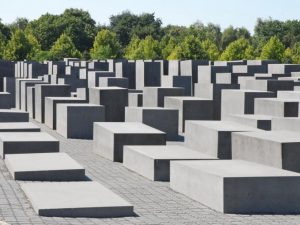
Such an important point of view. Stunning piece.
[…] Click Here to Read: Interview with Architect Peter Eisenman by Joanne Intrator om the Joanne Intrator.com website on August 10, 2016 […]